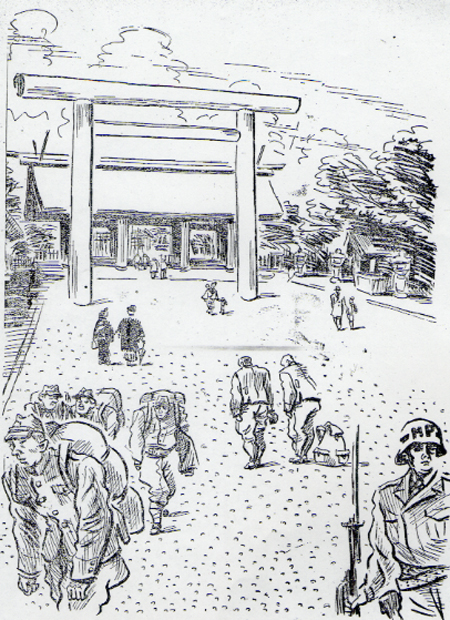|
Yasukini Shrine, Tokyo, 1947

Text by Alvin Grauer. Illustrated by Takamori Yakko."The tranquil appearance of this handsome Shinto shrine (Tokyo) seems strangely different from the description in the official guide book of its purpose. Yasukuni is dedicated to those who have been killed in the ten civil wars of 1869 and 1877 and the foreign wars of 1894-5, 1904-5, 1914-18, 1931-32, and 1937 to--. (We are happy to advise the guide book editors the date 1945 can now be added to replace that meaningful dash).
The souls of Japanese soldiers who fell in battle are enshrined here. Twice a year, in April and October, great and solemn festivals are held, and ladies of the Court spend a day inscribing the names of newly fallen soldiers. They were particularly busy last April catching up on the list. Yasukuni is strikingly handsome, as you can see. The big bronze Shinto Gate, (torii) stands seventy feet high--the largest bronze torii in Japan. (There's a forty-foot stone torii outside). A row of stone lanterns (ishi-toro) leads inside. The Japanese soldier with heavy rucksacks (same word in Japanese) are probably repatriates from China and have just paid their devotion to their fallen comrades. They are now on their way home to lay down their uniforms (gumpuku), änd start the joys and anguish of civilian existence in a democracy (just as tough as in America!). And the supercilious MP (Em-pee) is there to see that this one-of-the-most important Japanese shrines isn't made a stopping point by souvenir-hunting GI's who might (you can never tell) try to take home the soul of a Japanese General--just to show the folks back in Blytheville.
.........................
From: Grauer, Alvin. So I Went to Japan. Tokyo: Nippon Times, 1947.
| 